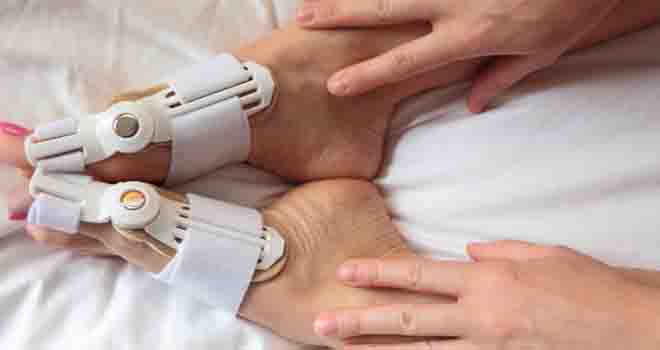Bunion / Toe surgery

You will be provided with a postop shoe for your comfort. Use the postop shoe when you are up. You may put weight on the heel of the shoe and use your crutches as necessary. Elevate the foot at heart level or above. For the first 5-7 days after surgery avoid having the foot dependent. Try and always have the foot elevated, at least up on a chair.
Dressings
You will have a bulky dressing over your foot. You may notice some bloody spotting coming through the outer dressing. Although it is unlikely to be significant bleeding, contact us if it continues to become saturated. Otherwise, any small area of spotting will dry and can be ignored until you remove the dressings. Do not remove the dressing unless instructed to do so.
Sutures
The sutures utilized in closing any wounds are not absorbable. They will be removed at approximately 10 to 14 days after surgery.
Ice
Ice and elevation will help minimize the pain and swelling after surgery, especially during the first few days. You can keep ice packs on the foot for 30 minutes every 1-2 hours during the first few days without risk of frostbite injury to the underlying skin as long as the original dressings are in place. The initial post-operative wrap involves multiple layers of cotton gauze and padding, therefore insulating the skin surface reasonably well. Once you have removed the original dressing I would recommend ice applications to the large toe region for only 20 minutes at a time every 2 hours as needed for pain and swelling.
Showers
You must keep the dressing dry and can use the bath with the foot hung out of the tub or sponge bath. If you must use the shower you will need to apply a plastic bag around the foot and tape it at the top. There are excellent cast protector products available locally at pharmacies or online from Amazon (Duro-Med). However, it is hard to keep the dressing absolutely dry and some leakage may occur. If the dressing gets a little wet allow it to dry.
Physical Therapy
Normally we will not have any physical therapy until 6-8 weeks after surgery. At that time we can do home exercises or physical therapy based on your individual needs and desires. We will discuss your exercises and activity limitations when you are seen in the office.
Office Follow-up
Please call our office within a few days following surgery to schedule your first follow-up visit for about 7 days after surgery. This can vary plus or minus several days depending on your schedule and ours, as we want the wound, swelling, and pain to settle down prior to the first dressing change. We will then do weekly dressing changes to adjust the position of the great toe as needed until 4 weeks after surgery. At that time we will start using a silicone toe spacer. We will use the postop shoe for the first 4-6 weeks after surgery. Then we want a shoe or scandal which will not put pressure on the great toe.
Medications
You will be provided with a prescription for a pain medication when you are ready to leave the hospital. Usually, we will prescribe hydrocodone, hydromorphone, or oxycodone. These are generic names for three different narcotic pain relievers. If you are aware of a certain pain medication that you have previously had problems with or one that you normally respond favorably to, please inform us so that we can give you the appropriate prescription. You may have the prescription prior to surgery to avoid filling it the day of surgery.
Complications
Bunion foot surgery is an outpatient surgery and postoperative complications are fortunately quite rare. The incidence of an infection is literally one out of thousands. The onset of symptoms would be approximately 5-7 days following surgery and would consist of a significant increase in pain, swelling, warmth, and redness of the extremity, fever, chills or night sweats. More common, but still quite rare, would be a small superficial infection or irritation at one of the skin incisions. There can also be a very small incidence of a blood clot developing deep within your arm veins or leg veins.
If you have had a previous blood clot, use estrogen, or have a family history of blood clots in the legs, arms or lungs you should probably be protected with TED hose and a blood thinner. If we did not start this let us know. If we recommended aspirin for blood clot protection you should use a baby aspirin twice a day for 2 weeks or as long as the leg or arm is immobilized. A blood clot would be characterized by a sudden onset of new pain (usually different from your surgical lower extremity pain) or tightness in the upper arm or more commonly the leg. This usually begins about 5-7 days from the day of surgery. The presence or absence of a clot can usually be determined by a simple non-invasive ultrasound test at the hospital.
